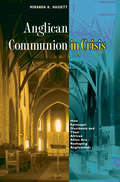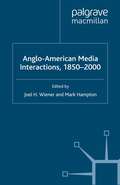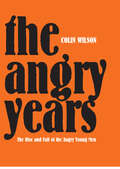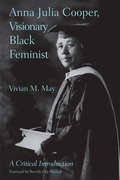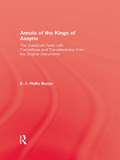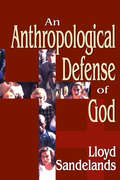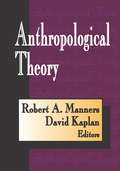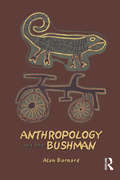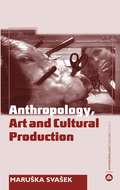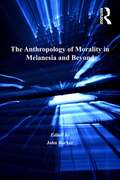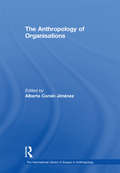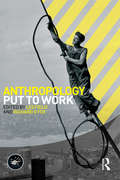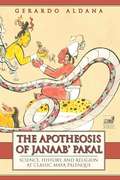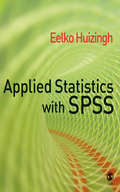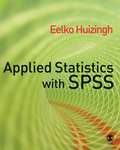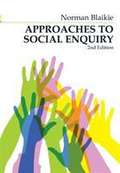- Table View
- List View
Anglican Communion in Crisis: How Episcopal Dissidents and Their African Allies Are Reshaping Anglicanism
by Miranda K. HassettThe sign outside the conservative, white church in the small southern U.S. town announces that the church is part of the Episcopal Church--of Rwanda. In Anglican Communion in Crisis, Miranda Hassett tells the fascinating story of how a new alliance between conservative American Episcopalians and African Anglicans is transforming conflicts between American Episcopalians--especially over homosexuality--into global conflicts within the Anglican church. In the mid-1990s, conservative American Episcopalians and Anglican leaders from Africa and other parts of the Southern Hemisphere began to forge ties in opposition to the American Episcopal Church's perceived liberalism and growing toleration of homosexuality. This resulted in dozens of American Episcopal churches submitting to the authority of African bishops. Based on wide research, interviews with key participants and observers, and months Hassett spent in a southern U.S. parish of the Episcopal Church of Rwanda and in Anglican communities in Uganda, Anglican Communion in Crisis is the first anthropological examination of the coalition between American Episcopalians and African Anglicans. The book challenges common views--that the relationship between the Americans and Africans is merely one of convenience or even that the Americans bought the support of the Africans. Instead, Hassett argues that their partnership is a deliberate and committed movement that has tapped the power and language of globalization in an effort to move both the American Episcopal Church and the worldwide Anglican Communion to the right.
Anglican Communion in Crisis: How Episcopal Dissidents and Their African Allies Are Reshaping Anglicanism (PDF)
by Miranda K. HassettThe sign outside the conservative, white church in the small southern U.S. town announces that the church is part of the Episcopal Church--of Rwanda. In Anglican Communion in Crisis, Miranda Hassett tells the fascinating story of how a new alliance between conservative American Episcopalians and African Anglicans is transforming conflicts between American Episcopalians--especially over homosexuality--into global conflicts within the Anglican church. In the mid-1990s, conservative American Episcopalians and Anglican leaders from Africa and other parts of the Southern Hemisphere began to forge ties in opposition to the American Episcopal Church's perceived liberalism and growing toleration of homosexuality. This resulted in dozens of American Episcopal churches submitting to the authority of African bishops. Based on wide research, interviews with key participants and observers, and months Hassett spent in a southern U.S. parish of the Episcopal Church of Rwanda and in Anglican communities in Uganda, Anglican Communion in Crisis is the first anthropological examination of the coalition between American Episcopalians and African Anglicans. The book challenges common views--that the relationship between the Americans and Africans is merely one of convenience or even that the Americans bought the support of the Africans. Instead, Hassett argues that their partnership is a deliberate and committed movement that has tapped the power and language of globalization in an effort to move both the American Episcopal Church and the worldwide Anglican Communion to the right.
Anglo-American Media Interactions, 1850-2000
by Joel H. Wiener Mark HamptonThis volume reveals the complicated ways in which British and American media have influenced each other over the past two centuries. In doing so, it adds an important transatlantic dimension to media scholarship, while demonstrating the crucial and varied ways in which media have helped build an Anglo-American 'special relationship'.
The Angry Years: The Rise And Fall Of The Angry Young Men
by Colin WilsonWhat were the achievements of the ’angry’ writers who emerged in the fifties? Historically, they gave birth to the satire movement of the 1960s-Beyond the Fringe, That Was the Week that Was and Private Eye. Their satire and irreverence aroused enthusiasm in man, and a new ‘anti-Establishment’ mood
Anna Julia Cooper, Visionary Black Feminist: A Critical Introduction
by Vivian M. MayVivian M. May explores the theoretical and political contributions of Anna Julia Cooper, a renowned Black feminist scholar, educator and activist whose ideas deserve far more attention than they have received. Drawing on Africana and feminist theory, May places Cooper's theorizing in its historical contexts and offers new ways to interpret the evolution of Cooper's visionary politics, subversive methodology, and defiant philosophical outlook. Rejecting notions that Cooper was an elitist duped by dominant ideologies, May contends that Cooper's ambiguity, code-switching, and irony should be understood as strategies of a radical methodology of dissent. May shows how across six decades of work, Cooper traced history's silences and delineated the workings of power and inequality in an array of contexts, from science to literature, economics to popular culture, religion to the law, education to social work, and from the political to the personal. May emphasizes that Cooper eschewed all forms of mastery and called for critical consciousness and collective action on the part of marginalized people at home and abroad. She concludes that in using a border-crossing, intersectional approach, Cooper successfully argues for theorizing from experience, develops inclusive methods of liberation, and crafts a vision of a fundamentally egalitarian social imaginary.
Anna Julia Cooper, Visionary Black Feminist: A Critical Introduction
by Vivian M. MayVivian M. May explores the theoretical and political contributions of Anna Julia Cooper, a renowned Black feminist scholar, educator and activist whose ideas deserve far more attention than they have received. Drawing on Africana and feminist theory, May places Cooper's theorizing in its historical contexts and offers new ways to interpret the evolution of Cooper's visionary politics, subversive methodology, and defiant philosophical outlook. Rejecting notions that Cooper was an elitist duped by dominant ideologies, May contends that Cooper's ambiguity, code-switching, and irony should be understood as strategies of a radical methodology of dissent. May shows how across six decades of work, Cooper traced history's silences and delineated the workings of power and inequality in an array of contexts, from science to literature, economics to popular culture, religion to the law, education to social work, and from the political to the personal. May emphasizes that Cooper eschewed all forms of mastery and called for critical consciousness and collective action on the part of marginalized people at home and abroad. She concludes that in using a border-crossing, intersectional approach, Cooper successfully argues for theorizing from experience, develops inclusive methods of liberation, and crafts a vision of a fundamentally egalitarian social imaginary.
Annals Of The Kings Of Assyria
by BudgeCollected for the first time by the eminent scholar E. A. Wallis Budge, this work contains all of the written records of the early Assyrian kings, from the reign of Irishum in about B.C. 2000 to the reign of Ashur-nasir-pal, which ended in B.C. 860. The texts are presented in Assyrian with complete English translations and, where appropriate, photographs of the original inscriptions. Budge supplements the texts with discussions of their historical and anthropological contexts, as well as notes on the problems encountered in translation. For its thoroughness and for the fascinating insights it provides, this work remains indispensable to anyone with a serious interest in ancient civilizations.
Annals Of The Kings Of Assyria
by BudgeCollected for the first time by the eminent scholar E. A. Wallis Budge, this work contains all of the written records of the early Assyrian kings, from the reign of Irishum in about B.C. 2000 to the reign of Ashur-nasir-pal, which ended in B.C. 860. The texts are presented in Assyrian with complete English translations and, where appropriate, photographs of the original inscriptions. Budge supplements the texts with discussions of their historical and anthropological contexts, as well as notes on the problems encountered in translation. For its thoroughness and for the fascinating insights it provides, this work remains indispensable to anyone with a serious interest in ancient civilizations.
An Anthropological Defense of God
by Lloyd E. SandelandsAnthropology--the study of man--is unlike every other study because humans are its subject. And because we are its subject we cannot manage the philosophic and emotional distance necessary to see clearly. Unable to stand apart from ourselves to comprehend our own truth, we are compelled to assume things about ourselves that we cannot prove. In a word, anthropology begins in faith. Lloyd Sandelands approaches the anthropological quest for God by comparing the faiths of modern social science and of the Christian church.Sandelands describes the social scientific faith articulated by Hume, Kant, Rousseau, Schopenhauer among others, as an imagined state of nature that sees the individual as solitary, self-sufficient, and contented. By contrast, the Christian faith unites us as male and female persons in one flesh before God. The challenge in the author's view is to decide which faith to build our lives upon. Sandelands poses questions about the basic terms of human study--what is a person, and what is society?--and how do the different metaphysics of science and Church lead to different anthropologies?A worthwhile anthropology must address the questions of what constitutes human freedom, desire, and the nature of the good. Comparing the answers given by science and by the church, he finds that the one paradoxically denies freedom, denies want, and denies the good, while the other affirms freedom, affirms want, and affirms the good. Between these two anthropologies he finds there is but one true study of man.A companion to Sandelands' Man and Nature in God, his most recent book, An Anthropological Defense of God attempts to establish that an anthropology in God succeeds where an anthropology in science fails. Such success is measured not only by its ideas and findings about man, but even more by its wisdom in teaching us how to live.
An Anthropological Defense of God
by Lloyd E. SandelandsAnthropology--the study of man--is unlike every other study because humans are its subject. And because we are its subject we cannot manage the philosophic and emotional distance necessary to see clearly. Unable to stand apart from ourselves to comprehend our own truth, we are compelled to assume things about ourselves that we cannot prove. In a word, anthropology begins in faith. Lloyd Sandelands approaches the anthropological quest for God by comparing the faiths of modern social science and of the Christian church.Sandelands describes the social scientific faith articulated by Hume, Kant, Rousseau, Schopenhauer among others, as an imagined state of nature that sees the individual as solitary, self-sufficient, and contented. By contrast, the Christian faith unites us as male and female persons in one flesh before God. The challenge in the author's view is to decide which faith to build our lives upon. Sandelands poses questions about the basic terms of human study--what is a person, and what is society?--and how do the different metaphysics of science and Church lead to different anthropologies?A worthwhile anthropology must address the questions of what constitutes human freedom, desire, and the nature of the good. Comparing the answers given by science and by the church, he finds that the one paradoxically denies freedom, denies want, and denies the good, while the other affirms freedom, affirms want, and affirms the good. Between these two anthropologies he finds there is but one true study of man.A companion to Sandelands' Man and Nature in God, his most recent book, An Anthropological Defense of God attempts to establish that an anthropology in God succeeds where an anthropology in science fails. Such success is measured not only by its ideas and findings about man, but even more by its wisdom in teaching us how to live.
Anthropological Theory
by David KaplanAnthropological theory has been much discussed in recent years, yet the crucial questions still remain--how can it be defined, how is it developed, how is it to be applied, and how can one confirm it? The editors of Anthropological Theory answer these questions by presenting essays relating to various aspects of anthropological theory. Their selections from widely scattered and often difficult-to-obtain sources present a comprehensive set of writings that describe the current position and issues involved in theory.The development of field work in anthropology generated a tremendous emphasis on empirical data and research. The plethora of information awaiting collection and the enthusiasm with which the field embraced it so immersed anthropologists that they were unable to relate this new information to the field as a whole. Manners and Kaplan believe that this lack of generalization had a profoundly negative effect upon the discipline. Therefore, they look closely into the relationship between field work and theory in an opening essay and go on to present material that demonstrates the value and the necessity of theory in anthropology. Essays by anthropologists and other social scientists deal with ""explanation,"" evolution, ecology, ideology, structuralism, and a number of other issues reflecting throughout the editors' conviction that anthropology is a science, the goal of which is to produce generalizations about sociocultural phenomena.The book provides necessary perspective for examining and evaluating the crucial intellectual concerns of modern anthropology and will therefore be important for the work of every anthropologist.
Anthropological Theory
by David KaplanAnthropological theory has been much discussed in recent years, yet the crucial questions still remain--how can it be defined, how is it developed, how is it to be applied, and how can one confirm it? The editors of Anthropological Theory answer these questions by presenting essays relating to various aspects of anthropological theory. Their selections from widely scattered and often difficult-to-obtain sources present a comprehensive set of writings that describe the current position and issues involved in theory.The development of field work in anthropology generated a tremendous emphasis on empirical data and research. The plethora of information awaiting collection and the enthusiasm with which the field embraced it so immersed anthropologists that they were unable to relate this new information to the field as a whole. Manners and Kaplan believe that this lack of generalization had a profoundly negative effect upon the discipline. Therefore, they look closely into the relationship between field work and theory in an opening essay and go on to present material that demonstrates the value and the necessity of theory in anthropology. Essays by anthropologists and other social scientists deal with ""explanation,"" evolution, ecology, ideology, structuralism, and a number of other issues reflecting throughout the editors' conviction that anthropology is a science, the goal of which is to produce generalizations about sociocultural phenomena.The book provides necessary perspective for examining and evaluating the crucial intellectual concerns of modern anthropology and will therefore be important for the work of every anthropologist.
Anthropology and the Bushman
by Alan BarnardThe Bushman' is a perennial but changing image. The transformation of that image is important. It symbolizes the perception of Bushman or San society, of the ideas and values of ethnographers who have worked with Bushman peoples, and those of other anthropologists who use this work. Anthropology and the Bushman covers early travellers and settlers, classic nineteenth and twentieth-century ethnographers, North American and Japanese ecological traditions, the approaches of African ethnographers, and recent work on advocacy and social development. It reveals the impact of Bushman studies on anthropology and on the public. The book highlights how Bushman or San ethnography has contributed to anthropological controversy, for example in the debates on the degree of incorporation of San society within the wider political economy, and on the validity of the case for 'indigenous rights' as a special kind of human rights. Examining the changing image of the Bushman, Barnard provides a new contribution to an established anthropology debate.
Anthropology and the Bushman
by Alan BarnardThe Bushman' is a perennial but changing image. The transformation of that image is important. It symbolizes the perception of Bushman or San society, of the ideas and values of ethnographers who have worked with Bushman peoples, and those of other anthropologists who use this work. Anthropology and the Bushman covers early travellers and settlers, classic nineteenth and twentieth-century ethnographers, North American and Japanese ecological traditions, the approaches of African ethnographers, and recent work on advocacy and social development. It reveals the impact of Bushman studies on anthropology and on the public. The book highlights how Bushman or San ethnography has contributed to anthropological controversy, for example in the debates on the degree of incorporation of San society within the wider political economy, and on the validity of the case for 'indigenous rights' as a special kind of human rights. Examining the changing image of the Bushman, Barnard provides a new contribution to an established anthropology debate.
Anthropology, Art and Cultural Production (Anthropology, Culture and Society)
by Maruska SvasekThis book provides an introduction to anthropological perspectives on art. *BR**BR*Svasek defines art as a social process. We study not only the artefacts themselves and the values attributed to them, but also the process of production and its wider context. *BR**BR*Providing a critical overview of various anthropological theories of art, Svasek offers a new perspective which centres on the analysis of commoditisation, aestheticisation and object agency. She explores the process of collecting and exhibiting art works and how this relates to art's production, distribution and consumption in an increasingly global market. *BR**BR*The book outlines the significance of art and aesthetics in everyday life, and examines the shifting boundaries between art and other categories such as kitsch, souvenirs, propaganda and pornography. *BR**BR*Finally, Svasek argues for an anthropological perspective that links the production and consumption of artefacts to political, religious and other cultural processes.*BR**BR*Ideal as a teaching text, this book gives a detailed overview of themes that are central to the fields of art history, art sociology and cultural studies.
The Anthropology of Morality in Melanesia and Beyond (Anthropology and Cultural History in Asia and the Indo-Pacific)
by John BarkerThe Anthropology of Morality in Melanesia and Beyond examines how Melanesians experience and deal with moral dilemmas and challenges. Taking Kenelm Burridge’s seminal work as their starting point, the contributors focus upon public situations and types of people that exemplify key ethical contradictions for members of moral communities. While returning to some classical concerns, such as the roles of big men and sorcerers, the book opens new territory with richly textured ethnographic studies and theoretical reviews that explore the interface between the values associated with indigenous village life and the ethical orientations associated with Christianity, the state, the marketplace, and other facets of ’modernity'. A major contribution to the emerging field of the anthropology of morality, the volume includes some of the most prominent scholars working in the discipline today, including Bruce Knauft, Joel Robbins, F.G. Bailey, Deborah Gewertz and Frederick Errington.
The Anthropology of Morality in Melanesia and Beyond (Anthropology and Cultural History in Asia and the Indo-Pacific)
by John BarkerThe Anthropology of Morality in Melanesia and Beyond examines how Melanesians experience and deal with moral dilemmas and challenges. Taking Kenelm Burridge’s seminal work as their starting point, the contributors focus upon public situations and types of people that exemplify key ethical contradictions for members of moral communities. While returning to some classical concerns, such as the roles of big men and sorcerers, the book opens new territory with richly textured ethnographic studies and theoretical reviews that explore the interface between the values associated with indigenous village life and the ethical orientations associated with Christianity, the state, the marketplace, and other facets of ’modernity'. A major contribution to the emerging field of the anthropology of morality, the volume includes some of the most prominent scholars working in the discipline today, including Bruce Knauft, Joel Robbins, F.G. Bailey, Deborah Gewertz and Frederick Errington.
The Anthropology of Organisations (The International Library of Essays in Anthropology)
by Alberto Corsín JiménezThe Anthropology of Organisations offers a critical overview of the work that for over sixty years anthropologists have been carrying out in and on organisations and of the contribution that this work has made to social theory at large. Moving beyond earlier preoccupations with ’culture’ and ’relationality’, the volume brings together a selection of classic and contemporary articles that cast new light on the relevance of ethnography for organisational and social theory. It offers an indispensable resource for students and scholars interested in the politics behind the institutionalisation of social life.
The Anthropology of Organisations (The International Library of Essays in Anthropology)
by Alberto Corsin JimenezThe Anthropology of Organisations offers a critical overview of the work that for over sixty years anthropologists have been carrying out in and on organisations and of the contribution that this work has made to social theory at large. Moving beyond earlier preoccupations with ’culture’ and ’relationality’, the volume brings together a selection of classic and contemporary articles that cast new light on the relevance of ethnography for organisational and social theory. It offers an indispensable resource for students and scholars interested in the politics behind the institutionalisation of social life.
Anthropology Put to Work (Wenner-Gren International Symposium Series)
by Les W. Field Richard G. FoxHow do anthropologists work today and how will they work in future? While some anthropologists have recently called for a new "public" or "engaged" anthropology, profound changes have already occurred, leading to new kinds of work for a large number of anthropologists. The image of anthropologists "reaching out" from protected academic positions to a vaguely defined "public" is out of touch with the working conditions of these anthropologists, especially those junior and untenured. The papers in this volume show that anthropology is put to work in diverse ways today. They indicate that the new conditions of anthropological work require significant departures from canonical principles of cultural anthropology, such as replacing ethnographic rapport with multiple forms of collaboration. This volume's goal is to help graduate students and early-career scholars accept these changes without feeling something essential to anthropology has been lost. There really is no other choice for most young anthropologists.
Anthropology Put to Work (Wenner-Gren International Symposium Series)
How do anthropologists work today and how will they work in future? While some anthropologists have recently called for a new "public" or "engaged" anthropology, profound changes have already occurred, leading to new kinds of work for a large number of anthropologists. The image of anthropologists "reaching out" from protected academic positions to a vaguely defined "public" is out of touch with the working conditions of these anthropologists, especially those junior and untenured. The papers in this volume show that anthropology is put to work in diverse ways today. They indicate that the new conditions of anthropological work require significant departures from canonical principles of cultural anthropology, such as replacing ethnographic rapport with multiple forms of collaboration. This volume's goal is to help graduate students and early-career scholars accept these changes without feeling something essential to anthropology has been lost. There really is no other choice for most young anthropologists.
The Apotheosis of Janaab' Pakal: Science, History, and Religion at Classic Maya Palenque (Mesoamerican Worlds)
by Gerardo AldanaThe Apotheosis of Janaab' Pakal takes up anew the riddles within a number of Maya hieroglyphic inscriptions first recognized by Floyd Lounsbury. Gerardo Aldana unpacks these mathematical riddles using an approach grounded in a reading of the texts made possible by recent advances in decipherment. Using a history of science methodology, he expands upon (and sometimes questions) the foundational work of archaeoastronomers. Aldana follows three lines of investigation: a reading of the hieroglyphic inscriptions of the Classic period (a.d. 250-900), mathematical analysis to recover Classic Maya astronomical practice, and a historiography of Maya astronomy. Quoted hieroglyphs appear throughout the text for cross-examination. Aldana reveals the social and political context of Maya astronomy by explicating the science and calendrical calculations found in the tablets of the Temple of Inscriptions and the Cross Group from the city of Palenque. He offers a compelling interpretation of an 819-day count, demonstrating its utility as an astronumerological tool that Maya scribes used to simplify complex calculations. During troubled times in Palenque, Aldana contends, Kan Balam II devised a means to preserve the legitimacy of his ruling dynasty. He celebrated a re-creation of the city as a contemporary analogue of a mythical Creation on three levels: monumental construction for a public audience, artistic patronage for an elite audience, and a secret mathematical astronomical language only for rulers-elect. Discussing all of these efforts, Aldana focuses on the recovery of the secret language and its historical context.
Applied Statistics with SPSS
by Eelko HuizinghAccessibly written and easy to use, Applied Statistics Using SPSS is an all-in-one self-study guide to SPSS and do-it-yourself guide to statistics. Based around the needs of undergraduate students embarking on their own research project, the text's self-help style is designed to boost the skills and confidence of those that will need to use SPSS in the course of doing their research project. The book is pedagogically well developed and contains many screen dumps and exercises, glossary terms and worked examples. Divided into two parts, Applied Statistics Using SPSS covers : 1. A self-study guide for learning how to use SPSS. 2. A reference guide for selecting the appropriate statistical technique and a stepwise do-it-yourself guide for analysing data and interpreting the results. 3. Readers of the book can download the SPSS data file that is used for most of the examples throughout the book here. Geared explicitly for undergraduate needs, this is an easy to follow SPSS book that should provide a step-by-step guide to research design and data analysis using SPSS.
Applied Statistics with SPSS (PDF)
by Dr Eelko K HuizinghAccessibly written and easy to use, Applied Statistics Using SPSS is an all-in-one self-study guide to SPSS and do-it-yourself guide to statistics. Based around the needs of undergraduate students embarking on their own research project, the text's self-help style is designed to boost the skills and confidence of those that will need to use SPSS in the course of doing their research project. The book is pedagogically well developed and contains many screen dumps and exercises, glossary terms and worked examples. Divided into two parts, Applied Statistics Using SPSS covers : 1. A self-study guide for learning how to use SPSS. 2. A reference guide for selecting the appropriate statistical technique and a stepwise do-it-yourself guide for analysing data and interpreting the results. 3. Readers of the book can download the SPSS data file that is used for most of the examples throughout the book here. Geared explicitly for undergraduate needs, this is an easy to follow SPSS book that should provide a step-by-step guide to research design and data analysis using SPSS.
Approaches To Social Enquiry: Advancing Knowledge (PDF)
by Norman BlaikieSince its initial publication, this highly respected text has provided students with a critical review of the major research paradigms in the social sciences & the logics or strategies of enquiry associated with them. This second edition has been revised and updated.
